Why would I need a root canal treatment?
Root canal treatment is necessary when the pulp becomes inflamed or infected. In these circumstances, the pulp of your tooth is no longer able to heal itself. The most common reasons for inflammation or infection are deep cavities, cracks or chips, repeated dental procedures and trauma. If pulp disease is left untreated, it can cause pain or lead to an abscess. Common signs and symptoms associated with pulp disease are; prolonged sensitivity to cold or heat, discoloration of the tooth, swelling around the gum or tenderness of the tooth to pressure/biting. Some times infected pulp could be in the chronic stage in that case the tooth may be symptom free.
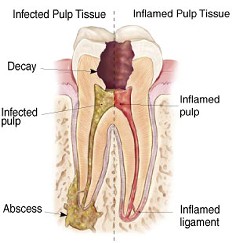
What steps are involved in a root canal treatment?
A local anesthetic will be given to numb the tooth. A sheet of latex called the “rubber dam” (we’ve got non-latex ones too) will be placed around the tooth to isolate it, hence keeping it clean and dry during treatment. An access opening will is made through the chewing surface of the tooth to explore inside of the tooth. Soft infected tissue will be removed from the root canal system and the canals will be shaped, disinfected, filled and sealed.
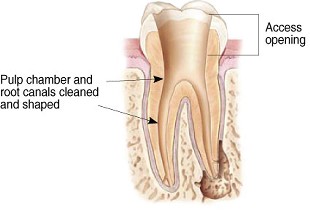
Once the root canals are shaped and disinfected they are filled with a biocompatible material called Gutta Percha which is a rubber like material obtained from various species of rubber trees. The access opening on the chewing surface of the tooth will be restored with a temporary filling.
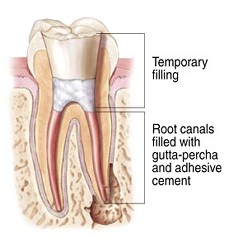
After your root canal treatment has been completed within 1-3 weeks you should return to your family dentist to remove the temporary filling and determine what type of restoration is best for your tooth. It is strongly recommended that the bicuspids and molars to be restored with a crown.

Will I need to return to your office for additional visits?
Once your endodontic treatment is completed, it is wise to monitor your healing over time. This service is included at no additional charge to you. We will attempt to notify you when follow-up monitoring is appropriate.
What is retreatment?
Occasionally a tooth that has undergone endodontic, treatment fails to heal or pain continues despite therapy. Although rare, sometimes a tooth initially responds to root canal therapy but becomes painful or diseased months or years later. When either of these situations occur, the tooth often can be maintained with a second endodontic treatment.
What is root surgery/apicectomy?
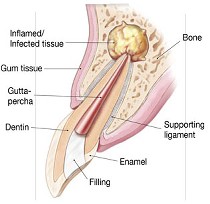
Occasionally a tooth that has undergone endodontic, treatment fails to heal or pain continues despite therapy. Although rare, sometimes a tooth initially responds to root canal therapy but becomes painful or diseased months or years later. When either of these situations occur, the tooth often can be maintained with a second endodontic treatment.
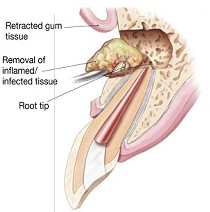
An incision is made in the gum tissue to expose the bone and surrounding infected/inflamed tissue. The damaged tissue is removed along with the end of the root tip.
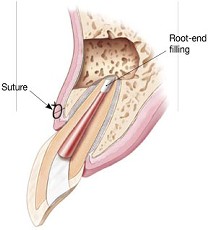
A root-end filling is placed to prevent re-infection of the root and the gum is sutured.
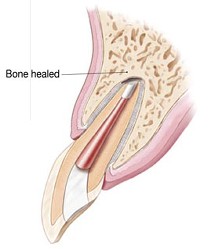
The bone naturally heals around the root over a period of months restoring full function. Following the procedure, there may be some discomfort or slight swelling while the incision heals.
What is the Endodontist”s role in diagnosing referred pain and treating traumatized teeth?
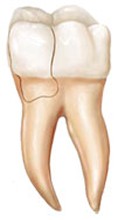 Pulp damage is sometimes caused by a blow to the mouth, and the endodontist specializes in treating these traumatic injuries. For example, a blow to a child’s permanent tooth that is not fully developed can cause the root to stop growing. A procedure called apexification stimulates bone to be deposited at the end of the root which makes it possible to then save the tooth through a root canal procedure. An endodontist is specially trained in procedures for replanting teeth that have been knocked out of their sockets.
Pulp damage is sometimes caused by a blow to the mouth, and the endodontist specializes in treating these traumatic injuries. For example, a blow to a child’s permanent tooth that is not fully developed can cause the root to stop growing. A procedure called apexification stimulates bone to be deposited at the end of the root which makes it possible to then save the tooth through a root canal procedure. An endodontist is specially trained in procedures for replanting teeth that have been knocked out of their sockets.